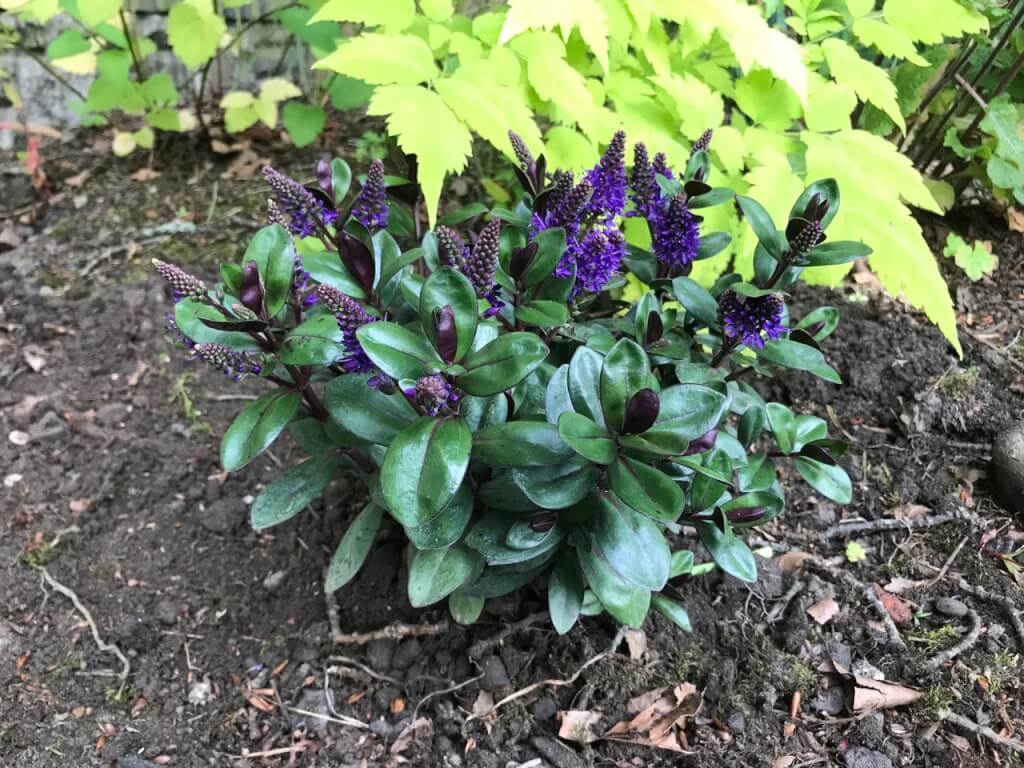Hebes, known for their attractive foliage and flowers, are susceptible to several common diseases, primarily caused by fungi and environmental stress. The issues with Hebes are usually caused by water stress and humidity. They have very few pests and even slugs will mostly leave them alone.
Here are the most common diseases that affect Hebe plants and their treatments:
1.Powdery Mildew
Symptoms: White, powdery growth on leaves and stems of Hebes, often seen during dry, warm conditions.
Treatment: Improve air circulation by pruning, water plants at the base to keep foliage dry, and apply fungicides like sulfur or neem oil.
2. Root Rot
Symptoms: Yellowing leaves, stunted growth, and wilting due to overly wet or poorly drained soil, leading to fungal infection in the roots. This usually impacts Hebes when they have just been planted, and the shrub tends to wilt and die very quickly.
Treatment: Improve drainage by amending the soil, reducing watering, and removing severely infected plants. Fungicide drenches can help manage the disease, but for the most part, once you have this, your Hebe is a gonna. So always buy healthy plants from reputable nurseries.
3. Botrytis (Gray Mold)
Symptoms: Gray, fuzzy mould on leaves, stems, or flowers, especially in humid or overcrowded conditions. Looks a bit like dirty cotton wool.
Treatment: Remove affected parts, ensure good air circulation, and reduce humidity. Use fungicides like copper-based sprays to control outbreaks.
4. Leaf Spot
Symptoms: This is what you had on your Hebe. Brown or black spots on leaves, caused by fungal or bacterial infections. It often results in premature leaf drop.
Treatment: Remove and dispose of infected leaves, avoid overhead watering, and treat with a fungicide containing copper or mancozeb. Do not compost or mulch; you just spread the spores around!
5. Phytophthora (Stem Rot)
Symptoms: Wilting and blackened stems near the base, caused by a soil-borne pathogen in waterlogged conditions. This is probably the most severe Hebe disease you can get and is pretty much irreparable.
Treatment: Ensure well-drained soil, reduce watering, and use a fungicide specifically designed for Phytophthora control.
Hebes are one of the UK's most popular shrubs, and for a good reason, they are super resilient and beginner gardener-proof. Even for time-poor gardeners, I often throw in a few Hebes to their planting plans to bring year-round structure and evergreen greenage to their gardens.s Let's see why they are so popular so other Ninjas can benefit from planting then.

1. Adaptability to Varied Soil Conditions
Hebe plants can thrive in a wide range of soil types, from poor, sandy soils to more fertile loams. While they prefer well-drained soils, they are quite tolerant of less-than-ideal conditions, allowing them to survive in environments that may be challenging for other shrubs.
2. Drought Resistance
Hebes are highly drought-tolerant once established, which makes them ideal for areas with dry summers or irregular rainfall. Their leaves often have a waxy coating or fine hairs that help reduce water loss through transpiration, allowing the plants to conserve moisture during dry periods.
3. Tolerance to Salt and Coastal Winds
Hebes are frequently found in coastal areas because of their high tolerance to salty air and strong winds. This resilience makes them a perfect choice for seaside gardens, where other plants may struggle to survive.
4. Cold Hardiness
While Hebes generally prefer mild climates, many varieties are hardy enough to withstand frost and cold winters. Some Hebe species, such as Hebe albicans and Hebe ‘Autumn Glory’, are known to survive temperatures as low as -10°C (14°F), though protection may be needed during extreme winters.
5. Compact, Dense Growth
Hebes have a compact and dense growth habit, which protects their inner branches and root systems from environmental stresses like wind or cold. Their close-packed leaves form a natural barrier against drying winds and frost.
6. Evergreen Nature
Being evergreen, Hebe shrubs retain their leaves year-round. This allows them to continue photosynthesis and conserve energy, even in colder months, contributing to their hardiness and long-term survival.
7. Low Maintenance
Hebe shrubs require minimal care, making them tough and easy to grow in a variety of settings. They don’t need frequent pruning or fertilizing, and their natural resistance to pests and diseases further enhances their hardiness.
8. Natural Resilience to Pests and Diseases
While not immune, Hebes are relatively resistant to many common garden pests and diseases compared to more delicate plants. Their tough leaves and stems make them less appealing to herbivores, and they are less likely to suffer from severe pest infestations.
I hope that helps?
Lee Garden Ninja



